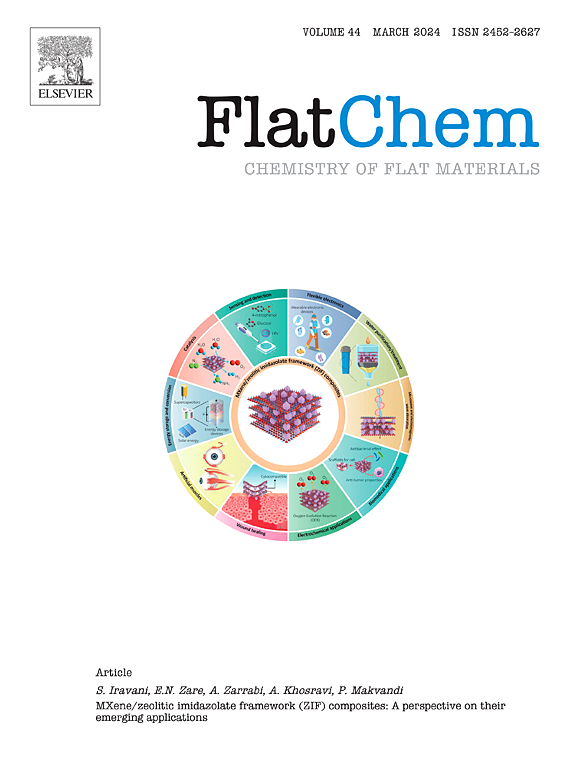用Na掺杂提高单层SnS热电性能的理论研究
IF 6.2
3区 材料科学
Q2 CHEMISTRY, PHYSICAL
引用次数: 0
摘要
为了探索新型高性能热电材料,我们从理论上计算了SnS单层热电材料的塞贝克系数、电导、导热系数、功率因数和优值ZT等热电输运特性。与重金属掺杂不同,采用经济环保的Na掺杂提高单层SnS的ZT。结果表明,Na的掺入可以使最大ZT沿扶手椅方向和之字形方向分别增大,且ZT的最高峰移动到化学势μ=0eV附近,表明相应的TE器件可以在低偏置电压下工作。当温度从300 K升高到800 K时,原始SnS单层膜沿扶手椅(之字形)方向的最大ZT从0.89增加到2.26(从1.33增加到2.89),掺杂na单层膜沿扶手椅(之字形)方向的最大ZT从1.24增加到2.45(从1.44增加到2.86)。这意味着na掺杂的SnS单层可以用于设计有前途的TE器件,工作在宽温度范围和低偏置电压下。本文章由计算机程序翻译,如有差异,请以英文原文为准。

Improving the thermoelectric performance of the SnS monolayer by Na doping: A theoretical study
Aiming at exploring new thermoelectric (TE) materials of high performance, we theoretically calculate the TE transport properties including the Seebeck coefficient, electrical conductance, thermal conductance, power factor, and figure of merit of the SnS monolayer. Different from the heavy-metal doping, the economical and environment-friendly Na doping is adopted to improve the of the monolayer SnS. It is shown that the Na doping can increase the maximum along the armchair and zigzag directions, respectively, and the highest peak is moved to the proximity of chemical potential , which indicates that the corresponding TE device can work at a low bias voltage. As the temperature increases from 300 K to 800 K, the maximum of the pristine SnS monolayer is increased from 0.89 to 2.26 (from 1.33 to 2.89) along the armchair (zigzag) direction, and the maximum of the Na-doped one is increased from 1.24 to 2.45 (from 1.44 to 2.86) along the armchair (zigzag) direction. This implies that the Na-doped SnS monolayer can be utilized to design promising TE devices working in a broad temperature scope and at a lower bias voltage.
求助全文
通过发布文献求助,成功后即可免费获取论文全文。
去求助
来源期刊

FlatChem
Multiple-
CiteScore
8.40
自引率
6.50%
发文量
104
审稿时长
26 days
期刊介绍:
FlatChem - Chemistry of Flat Materials, a new voice in the community, publishes original and significant, cutting-edge research related to the chemistry of graphene and related 2D & layered materials. The overall aim of the journal is to combine the chemistry and applications of these materials, where the submission of communications, full papers, and concepts should contain chemistry in a materials context, which can be both experimental and/or theoretical. In addition to original research articles, FlatChem also offers reviews, minireviews, highlights and perspectives on the future of this research area with the scientific leaders in fields related to Flat Materials. Topics of interest include, but are not limited to, the following: -Design, synthesis, applications and investigation of graphene, graphene related materials and other 2D & layered materials (for example Silicene, Germanene, Phosphorene, MXenes, Boron nitride, Transition metal dichalcogenides) -Characterization of these materials using all forms of spectroscopy and microscopy techniques -Chemical modification or functionalization and dispersion of these materials, as well as interactions with other materials -Exploring the surface chemistry of these materials for applications in: Sensors or detectors in electrochemical/Lab on a Chip devices, Composite materials, Membranes, Environment technology, Catalysis for energy storage and conversion (for example fuel cells, supercapacitors, batteries, hydrogen storage), Biomedical technology (drug delivery, biosensing, bioimaging)
 求助内容:
求助内容: 应助结果提醒方式:
应助结果提醒方式:


